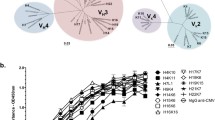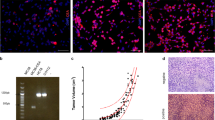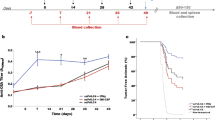Abstract
The immune response of CAF1 mice to various synthetic peptides (SP) related to the amino acid sequence (PDTRPAPGSTAPPAHGVTSA) of the tandem repeat of the MUC1 human breast mucin core peptide was evaluated. The most immunogenic preparations of the synthetic peptides were those conjugated to keyhole limpet hemocyanin (KLH) or clustered in a dendritic multiple antigenic peptide (MAP-4) configuration. The mice were immunized subcutaneously with synthetic peptides emulsified in RIBI adjuvant, employing various immunization protocols. Equivalently high IgG responses were induced using SP-KLH conjugates (GVTSAPDTRPAPGSTA-KLH) or an SP — MAP-4 chimeric configuration (SP1-6), which also included a universal malarial CST-3 T-helper epitope (SP1-6 = SAPDTRPAEKKIAKMEKASSVFNVVNS — MAP-4). These IgG antibodies bound both the appropriate MUC1 synthetic peptides and the cell surface expressed MUC1 mucin on murine mammary cells that had been transfected with the human MUC1 gene and a human breast cancer cell line that expresses cell-surface MUC1. A MAP-4 molecule, which included the entire 20-aminoacid sequence of the MUC1 tandem repeat (SP1-5 = PDTRPAPGSTAPPAHGVTSA—MAP-4) induced a poor IgG response. In contrast, all three types of molecule: SP-KLH, SP1-6 and SP1-5, were found to be good immunogens for the induction of specific delayedtype hypersensitivity (DTH) reactions measured using either synthetic peptides or MUC1-transfected cells. In addition, immunization with irradiated MUC1-transfected cells induced strong DTH reactions measured using synthetic peptides that expressed the PDTRP sequence, which has been shown to be, or to overlap, a T cell epitope in humans and a B cell epitope in mice. Finally, it was demonstrated that synthetic MUC1 peptide “vaccines” could be used both prophylactically and therapeutically to inhibit the growth of MUC1-transfected tumor cells and prolong the survival of tumor-bearing mice.
Similar content being viewed by others
References
Barnd DL, Lan MS, Metzgar RS, Finn OJ (1989) Specific, major histocompatibility complex-unrestricted recognition of tumor-associated mucins by human cytotoxic T cells. Proc Natl Acad Sci USA 86: 7159
Burchell J, Gendler S, Taylor-Papadimitriou J, Girling A, Lewis A, Millis R, Lamport D (1987) Development and characterization of breast cancer reactive monoclonal antibodies directed to the core protein of the human milk mucin. Cancer Res 47: 5476
Codington JF, Frim DM (1983) Cell-surface macromolecular and morphological changes related to allotransplantability in the TA3 tumor. In: Manson LA (ed) Biomembranes, vol 2. Plenum, New York, p 207
Codington JF, Bhavanandan VP, Bloch KJ, Nikrui N, Ellard JV, Wang PS, Jeanloz RW (1984) Antibody to epiglycanin and radioimmunoassay to detect epiglycanin-related glycoproteins in body fluids of cancer patients. JNCI 73: 1029
Fung PS, Longenecker BM (1991) Specific immunosuppressive activity of epiglycanin, a mucin-like glycoprotein secreted by a murine mammary adenocarcinoma (TA3-Ha). Cancer Res 51: 1170
Fung PYS, Madej M, Koganty R, Longenecker BM (1990) Active specific immunotherapy of a murine mammary adenocarcinoma using a synthetic tumor-associated glycoconjugate. Cancer Res 50: 4308
Friberg S Jr (1972) Comparison of an immunoresistant and an immunosusceptible ascites subline from murine tumor TA3: I. Transplantability, morphology and some physicochemical characteristics. JNCI 48: 1463
Gendler S, Taylor-Papadimitriou J, Duhig T, Rothbard J, Burchell J (1988) A highly immunogenic region of a human polymorphic epithelial mucin expressed by carcinomas is made up of tandem repeats. Biol Chem 263: 12 820
Gendler SJ, Lancaster CA, Taylor-Papadimitriou J, Duhig T, Peat N, Burchell J, Pemberton L, Lalani E-N, Wilson D (1990) Molecular cloning and expression of the human tumor-associated polymorphic epithelial mucin, PEM. Biol Chem 265: 15 286
Hanisch F, Uhlenbruck G, Egge H, Peter-Katalinic J (1989) A B72.3 second-generation-monoclonal antibody (CC49) defines the mucincarried carbohydrate epitope Galβ(1–3)(NeuAcα(2–6))GalNAc. Biol Chem Hoppe-Seyler 370: 21
Hareuveni M, Gautier C, Kieny M-P, Wreschner D, Chambon P, Lathe R (1990) Vaccination against tumor cells expressing breast cancer epithelial tumor antigen. Proc Natl Acad Sci USA 87: 9498
Henningson CM, Selvaray S, MacLean GD, Suresh MR, Noujaim AA, Longenecker BM (1987) T cell recognition of tumorassociated glycoprotein and its synthetic carbohydrate epitopes: stimulation of anticancer T cell immunity in vivo. Cancer Immunol Immunother 25: 231
Ho PC, Muteh DA, Winkel KD, Saul AJ, Jones GL, Doran TJ, Rzepczyk CM (1990) Identification of two promiscuous T-cell epitopes from tetanus toxin. Eur J Immunol 20: 477
Hull SR, Bright A, Carraway KL, Abe M, Hayes DF, Kufe D (1989) Oligosaccharide differences in the DF3 sialomucin antigen from normal human milk and the BT-20 human breast carcinoma cell line. Cancer Commun 1: 261
Itzkowitz SH, Bloom EJ, Kokal WA, Modin G, Hakomori S-I, Kim YS (1990) Sialosyl-Tn: a novel mucin antigen associated with prognosis in colorectal cancer patients. Cancer 66: 1960
Jentoff N (1990) Why are proteinsO-glycosylated? Trends Biochem Sci 15: 291
Jerome KR, Barnd DL, Bendt KM, Boyer CM, Taylor-Papadimitriou J, McKenzie IFC, Bast RC Jr, Finn OJ (1991) Cytotoxic T-lymphocytes derived from patients with breast adenocarcinoma recognize an epitope present on the malignant cells. Cancer Res 51: 2908
Kahn M, Sugawara H, McGowan P, Okuno K, Nagoya S, Hellström KE, Hellström I, Greenberg P (1991) CD4+ cell clones specific for the human p97 melanoma-associated antigen can eradicate pulmonary metastases from a murine tumor expressing the p97 antigen. J Immunol 146: 3235
Kurosaka A, Kitagawa H, Fukui S, Numata Y, Nakada H, Funakoshi I, Kawasaki T, Ogawa T, Iijima H, Yamashina I (1988) A monoclonal antibody that recognizes a cluster of a disaccharide, NeuAcα2-6GalNAc, in mucin-type glycoproteins. J Biol Chem 263: 8724
Lalani E-N, Berdichevsky F, Boshell M, Shearer M, Wilson D, Stauss H, Gendler SJ, Taylor-Papadimitriou J (1991) Expression of the gene coding for a human mucin in mouse mammary tumour cells can affect their tumorigenicity. J Biol Chem 266: 15 420
Lan MS, Batra SK, Qi W-N, Metzgar RS, Hollingsworth MA (1990) Cloning and sequencing of a human pancreatic tumor mucin cDNA. J Biol Chem 265: 15 294
Layton GT, Devine PL, Warren JA, Birrell G, Xing P-X, Ward BG, McKenzie IFC (1990) Monoclonal antibodies reactive with the breast carcinoma-associated mucin core protein repeat sequence peptide also recognize the ovarian carcinoma-associated sebaceous gland antigen. Tumor Biol 11: 274
MacLean G, Longenecker BM (1991) Novel synthetic immunother-apeutic vaccines for cancer: induction of hapten specific humoral immunity with reactivity with tumor cells. In: SBI '91 Biological Therapy of Cancer-VI Program and Abstracts. Society for Biological Therapy 1991 Annual Meeting, Pittsburgh, Pennsylvania
MacLean GD, Bowen-Yacyshyn MB, Samuel J, Meikle A, Stuart G, Nation J, Poppema S, Jerry M, Koganty R, Wong T, Longenecker BM (1992) Active immunization of human ovarian cancer patients against a common carcinoma (Thomsen-Friedenreich) determinant using a synthetic carbohydrate antigen. J Immunother 11: 292
Miller SC, Hay ED, Codington JF (1977) Ultrastructural and histochemical differences in cell surface properties of strain-specific and non-strain specific TA3 adenocarcinoma cells. J Cell Biol 72: 511
Parry G, Beck JC, Moss L, Bartley J, Ojakian GK (1990) Determination of apical membrane polarity in mammary epithelial cell cultures. The role of cell-cell, cell-substrate and membrane-cytoskeletal interaction. Exp Cell Res 188: 302
Peat N, Gendler SJ, Lalani E-N, Duhig T, Taylor-Papadimitriou J (1992) Tissue specific expression of a human polymorphic epithelial mucin (MUC1) in transgenic mice. Cancer Res 52: 1954
Samuel J, Noujaim AA, MacLean GD, Suresh MR, Longenecker BM (1990) Analysis of human tumor-associated Thomsen-Friedenreich antigen. Cancer Res 50: 4801
Singhal A, Fohn M, Hakomori S (1991) Induction of α-N-acetylgalactosamine-O-serine/threonine (Tn) antigen-mediated cellular immune response for active immunotherapy in mice. Cancer Res 51: 1406
Sinigaglia F, Guttinger M, Kilgus J, Doran DM, Martile H, Etlinger H, Trzeciak A, Gillessen D, Pink JRL (1988) A malaria T-cell epitope recognized in association with most mouse and human MHC class II molecules. Nature 336: 778
Springer GF (1984) T and Tn, general carcinoma autoantigens. Science 224: 1198
Taylor-Papdimitriou J, Gendler SJ (1988) Molecular aspects of mucins. In: Hilgers J, Zotter S (eds) Cancer reviews. vol. 11–12. Munksgaard, Copenhagen, Denmark, p 11
Torben F, Orntoft NH, Langkilde NC (1990)O-Linked mucin-type glycoproteins in normal and malignant colon mucosa: lack of T-antigen expression and accumulation of Tn and sialosyl-Tn antigens in carcinomas. Int J Cancer 45: 666
Wong RCK, Remold-O'Donnell E, Vercelli D, Saneho J, Terhorst C, Rosen F, Geha R, Chatila T (1990) Signal transduction via leukocyte antigen CD43 (sialophorin). Feedback regulation by protein kinase C. J Immunol 144: 1455
Author information
Authors and Affiliations
Rights and permissions
About this article
Cite this article
Ding, L., Lalani, EN., Reddish, M. et al. Immunogenicity of synthetic peptides related to the core peptide sequence encoded by the human MUC1 mucin gene: Effect of immunization on the growth of murine mammary adenocarcinoma cells transfected with the human MUC1 gene. Cancer Immunol Immunother 36, 9–17 (1993). https://doi.org/10.1007/BF01789125
Received:
Accepted:
Issue Date:
DOI: https://doi.org/10.1007/BF01789125




